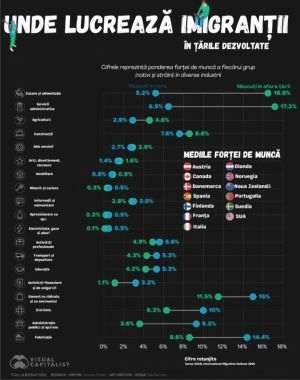The preparation of the campaigns for the presidential and parliamentary elections that will take place on November 24, respectively December 1, led the Government to increase the amount of budget expenditures in the second month of autumn in order to put an end to the protests of unions in several sectors of economic activity, allocating from the Reserve Fund additional amounts for each individual ministry, over and above the addition made through the budget rectification that took place in September. The breakdown of budget expenditures continued in October although, according to the budget execution for the first nine months of the current year, the deficit amounts to 5.44% of GDP (96.24 billion lei), a fact for which the Government drew up a plan, not a five-year plan, but for 7 years, which he submitted for approval to the European Commission, a document that includes the measures that will be implemented so that in 2031 we fall within the European budget deficit target of a maximum of 3% of GDP. The government has indicated that this gradual adjustment is essential to maintain a balance between the need for macroeconomic stability and boosting economic growth. In the context of a global economic slowdown and a relatively high budget deficit, the Ministry of Finance aims to increase tax revenues through reforms to make tax collection more efficient, reduce tax evasion and improve public debt sustainability. Until then, however, the Finances continued to borrow in October from the external capital markets, but also from the domestic market, including from the population through the launch of a new issue of Tezaur government bonds and through the fifth edition of the Fidelis program .
In these conditions, no one was surprised by the fact that on October 4 the former Board of Directors of the National Bank of Romania decided to maintain the monetary policy interest rate at the level of 6.5% per year, without any reduction compared to August 2024 when it reduced the interest rate by 0.25 percentage points. We are talking about the former Board of Directors, because from October 11, 2024, the BNR has a new composition of the Board of Directors voted by the plenary session of the Parliament on October 2, when, among other things, it was decided that Mugur Isărescu would remain one more term as governor of the central bank.
In this financial context, the Standard&Poor's (S&P) rating agency decided in the middle of last month to maintain Romania's government debt rating and stable outlook at BBB-/A3 for long-term and short-term foreign currency debt.
As winter is approaching, last month the Government approved measures regarding the level of safety in the operation of the national energy system. The winter program involves, first of all, the assessment of the country's electricity consumption between November 1, 2024 and March 31, 2025, so that, based on the assessment, energy is ensured at quality and supply safety parameters. In addition to this, in energy, decisions were also adopted regarding the completion of the hydropower plants at Bumbeşti, Dumitra and Livezeni, and the environmental agreement was issued for the completion of the Răstoliţa hydropower complex.
We also note that in October, the Executive decided to supplement the funds set up as guarantees for the Farmer's Credit program, to launch the de minimis aid scheme regarding the granting of vouchers for innovative SMEs and to unlock funding for projects started on the basis of the Start-Up Nation program 2022.
Read October in numbers
• Allocations from the Reserve Fund, budgetary execution in distress
The PSD-PNL coalition government, led by Prime Minister Marcel Ciolacu, continued in October to allocate large discretionary amounts from the Reserve Fund to the ministries, although in September it adopted the emergency ordinance through which it carried out the budget rectification. For example, during the past month, the Executive approved the additional allocation of the following amounts:
- 2 billion lei for the continuation of the financing of some projects from PNDL and from the Anghel Saligny program
- 540 million lei for the payment of some works on projects financed by PNRR
- 300 million lei for the National Construction Program
- 5 billion lei for the Ministry of Transport
- 400 million lei for the Farmer's Credit
- 1.1 billion lei for the National Health Insurance House
- 435 million lei for programs managed by the Ministry of European Investments and Projects
- 800 million lei for the Ministry of Education
- 224 million lei for the Ministry of Health.
The supplementation from the Reserve Fund of the respective budgets, budgets that received extra money and during the budget rectification, was done at the expense of the data that the Ministry of Finance had regarding the execution of the state budget after the first nine months of the current year.
According to her, the budget deficit recorded by our country in the first nine months of this year amounts to 5.44% of GDP (96.24 billion lei), being almost double the one recorded in the same period last year (56.46 billion lei). According to the Ministry of Finance, total revenues amounted to 415.98 billion lei, during the mentioned period, registering an advance of 13%, from year to year, growth supported by receipts from current revenues - insurance contributions, VAT, salary and income tax, corporate tax, excise and non-tax revenues. The general consolidated budget expenditures, in the amount of 512.22 billion lei, increased, in nominal terms, by 20.7%, in the period January-September 2024 compared to the similar period in 2023. Expressed as a percentage of the Gross Domestic Product, the budget expenditures , in the first nine months of the current year, registered an increase of 2.5 percentage points compared to the same period of 2023, from 26.5% of GDP to 29.0% of GDP.
Therefore, to support budget spending, the Ministry of Finance launched the first Samurai bond issue on October 4, 2024, which attracted considerable interest from investors in Japan. The total value of the bond issue was ¥33 billion, with firm purchase orders from investors totaling ¥34.1 billion. The issue was made in three tranches, of which 22 billion yen with a maturity of 3 years, with a yield of 2.10% per annum, 3.6 billion yen with a maturity of 5 years, with a yield of 2.63% respectively 7.4 billion yen with a maturity of 7 years and a yield of 3.14%. Through this issue, the Ministry of Finance sought to attract 200 million euros to the state budget.
Only three days later, on October 7, the Ministry of Finance launched a new issue of TEZAUR government bonds with maturities of 1.3 or 5 years, with advantageous annual interest rates of 5.85%, 6.60%, and 7%, respectively. According to Finance, in the 10 issues that have been held since the beginning of 2024, over 240,000 people have already invested over 12 billion lei.
Also in October, through the Fidelis government bond issuance program, which took place between October 2-11, 2024, the Ministry of Finance attracted over 3.5 billion lei, surpassing the record set in August, of 3.2 billion lei.
• Money for entrepreneurs
The government continued last month to provide financial support to the entrepreneurial environment. Thus, the Ministry of Economy, Entrepreneurship and Tourism was allocated the amount of 100 million lei, in order to cover some payments to the economic operators who submitted the settlement files for the Program to stimulate the establishment of small and medium enterprises Start-Up Nation Romania 2022. Thus, 500 of the approximately 2,210 applicants who have statements submitted by 11.10.2024 and who received payment approval by 10.04.2024, will have their financing contracts honored and will no longer have to pay loan installments and interest related month by month until the date of payment of the statements.
Moreover, the Executive approved the awarding of "Innovation Vouchers", totaling 8 million lei, to facilitate the purchase of research, development and innovation (CDI) services from research organizations by businesses. These vouchers are part of the de minimis aid scheme "De minimis aid for innovation vouchers", related to the National Plan for Research, Development and Innovation 2022-2027, managed by the Ministry of Research, Innovation and Digitization. Through this scheme, the Government aims to support SMEs that want to invest in R&D activities and develop partnerships with research organisations. The maximum estimated number of beneficiaries of the scheme is 250 enterprises, and the funds will be allocated annually, in the period 2024-2027, from the budget of the Ministry of Research, Innovation and Digitization. The de minimis aid scheme will be implemented until 31 December 2027, and project payments will be made until the end of 2030.
• Tax adjustment plan for 7 years
In this context, it has become increasingly clear that a serious fiscal adjustment plan is needed for the budget deficit to return to the maximum target of 3% of GDP established by European regulations. The respective plan was drawn up by the Ministry of Finance and sent by the Government to the European Commission for approval and was published on October 24. In the fiscal plan, the Government recognizes that the budget deficit will rise to 7.9% this year, although it originally built the budget on a 5% deficit. Thus, it assumes that it will gradually reduce it over the next 7 years at an average annual rate of one percentage point per year, to reach 2.5% of GDP in 2031.
The government wants to do this by increasing budget revenues from 29.6% of GDP in 2024, to 30.5% of GDP in 2025 and to 31% of GDP in 2026. The biggest increase will come from a fiscal reform provided for by milestones 207, 208 and 237 of the PNRR, with a budgetary impactestimated at at least 1.1% of GDP for the year 2025.
The government estimates that total expenditures will reach a maximum in 2025, at 41.2% of GDP, and subsequently their share will gradually decrease to the level of 35.9% in 2031. The decrease in expenditures will be done by gradually reducing the share of expenditures of personnel, from 9.3% of GDP to 8.3% of GDP, by implementing a policy of strongly moderate salary increases in the public sector, decreasing social assistance and investment expenses.
In addition to this, the plan also provides for a set of reforms, including in the tax field, an area where it is desired to optimize VAT collection and reform ANAF for more efficient collection, as well as reduce administrative expenses and unjustified subsidies.
Probably in light of all of the above, the Standard&Porrs rating agency reconfirmed Romania's government debt rating and stable outlook at BBB-/A3 for long-term and short-term foreign currency debt in the middle of last month. In the agency's opinion, the decision to reconfirm the sovereign rating and maintain the stable outlook is supported by the moderate stock of external and governmental debt and the solid growth prospects of our country, starting from 2025. At the same time, S&P anticipates that Romania's commitments within the Recovery Mechanism and Resilience (MRR) of the EU, as well as those under the Excessive Deficit Procedure (PDE) will continue to anchor the political reforms of the Romanian authorities.
The agency believes that Romania's economy will register an increase of 1.6% in 2024, respectively slightly below 3% on average in the period 2025-2027, given that our country will benefit from important European funds both from the Multiannual Financial Framework 2021 -2027, as well as from the Recovery and Resilience Mechanism. The main factors that could lead to the improvement of the country rating or the outlook are the substantial reduction of the fiscal deficit and the registration of a downward trend of public debt as a share of GDP. At the same time, the decrease in the costs of servicing the government's public debt by improving the debt structure and the strong reduction in external deficits can represent other positive factors for Romania's credit rating.
The main factor that could lead to a worsening of the country rating or the outlook is represented by the increase in government deficits above the current medium-term projections of the agency, which would also lead to the increase in the level of public debt as a percentage of GDP.
• Mugur Isărescu, another mandate as governor of the BNR
Last month started positively for Mugur Isărescu, the governor of the National Bank of Romania, whose mandate was renewed by the plenary session of the Parliament on October 2. On that occasion, the senators and deputies also voted on the composition of the new Board of Directors of the central bank, which took up its duties on October 11, in the following formula: Mugur Isărescu-president of the Board of Directors and governor of the BNR, Leonardo Badea- vice-president of the Board of Directors and first vice-governor of the National Bank of Romania, Florin Georgescu-member of the Board of Directors and vice-governor of the National Bank of Romania, Cosmin-Ştefan Marinescu-member of the Board of Directors and vice-governor of the National Bank of Romania, and members Aura-Gabriela Socol, Roberta Alma Anastase, Alexandru Nazare, Csaba Balint and Cristian Popa.
Previously, the former Board of Directors decided on October 4 to maintain the monetary policy interest rate at the level of 6.5% per annum, the maintenance of the interest rate for the credit facility (Lombard) at 7.5% per annum and the interest rate on the facility deposit at 5.5% per year. In justifying that decision, the members of the Council took into account the inflation rate, but also the assessments that show that the annual inflation rate will decrease until the end of the current year, a decrease that will primarily be driven by base effects and the deceleration of the increase in import prices. The members of the Council showed that great uncertainties and risks stem from the conduct of fiscal and revenue policy, considering, on the one hand, the result of the budget execution in the first eight months of the year and the characteristics of the recent budget correction, and, on the other hand , the fiscal-budgetary measures that could be implemented in the future in order to consolidate the budget, in the context of the medium-term structural fiscal plan submitted to the European Commission. Also in the chapter of significant uncertainties and risks, the evolution of energy and food prices continues to be recorded, as well as the future trajectory of the crude oil quotation, against the background of geopolitical tensions.
• Carpatica Feroviar SA replaces CFR Marfă
In October 2024, the Government approved the establishment of Carpatica Feroviar S.A., a strategic company intended for railway transports. It would play an important role in national mobility and security plans, having both commercial and strategic functions. According to the government decision establishing the company, Carpatica Feroviar will manage rail freight transport essential for the national economy and will ensure mobility in crisis situations. This is designed to complement Romania's strategic transport needs, especially in the context of possible emergency scenarios or regional tensions. The company will be financed through the budget of the Ministry of Transport, and over time the transport capacity will be expanded through investments that will allow the Carpatica Feroviar company to quickly intervene in mobilizing the necessary resources in emergency cases, thus contributing to national security. Through the new company, our country is strengthening its railway logistics infrastructure, with an emphasis on routes of strategic importance. This is a crucial component for maintaining access to commercial networks in crisis scenarios and for ensuring economic continuity, being designed to meet both civilian and military transport needs. According to the estimates of the Government representatives, the company will become fully operational on March 1, 2025, when the former state railway transport company, CFR Marfă, will also be liquidated.
• Money for Ukrainian pilot training, Norwegian support for Patriot
Through an emergency ordinance, the Government last month allocated funds and established the necessary framework for the training of Ukrainian pilots who will operate the F-16 fighter jets. This measure will allow F-16 aircraft to operate as Ukraine modernizes its air capabilities to deal with the current conflict. The Ukrainian personnel will be trained at the 86th Air Base in Feteşti. Also in the field of national security, the Executive decided to increase the budget
Ministry of National Defense to support the procurement of equipment and logistic infrastructure, as well as for the modernization of the military base in Feteşti. These measures are an integral part of the national defense plan, which aims to increase defensive capabilities and adapt to NATO standards.
Regarding the endowment of the Armed Forces, Norway announced at the end of October that it is allocating 127 million dollars for the purchase of a new Patriot system by Romania instead of the one donated in September to Ukraine. Norway's support comes after our country purchased 32 F-16 aircraft from that country for which it paid 388 million euros. The announcement regarding Norway's contribution to the purchase of the Patriot system by Romania was made recently at the Meeting of the Council of Nordic States, which is taking place these days in Reykjavik, Iceland, according to the cited source, that contribution being part of the Immediate Action Initiative for Air Defense (Immediate Action on Air Defense), coordinated by Germany. Norwegian support will allow Romania to strengthen its air defense capabilities, contributing directly to the security of NATO's eastern flank and to protecting the Euro-Atlantic space.
































































